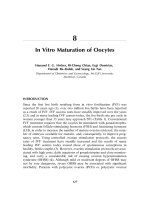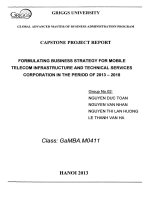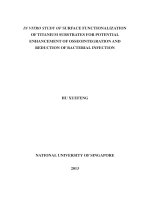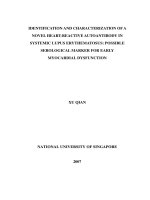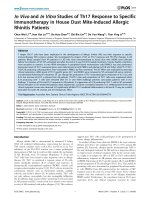In vitro inductions of gamma ray mutation for fusarium wilt resistance and characterization of mutants in regionally grown banana cultiva
Bạn đang xem bản rút gọn của tài liệu. Xem và tải ngay bản đầy đủ của tài liệu tại đây (378.92 KB, 13 trang )
Int.J.Curr.Microbiol.App.Sci (2019) 8(3): 1436-1448
International Journal of Current Microbiology and Applied Sciences
ISSN: 2319-7706 Volume 8 Number 03 (2019)
Journal homepage:
Original Research Article
/>
In vitro Inductions of Gamma Ray Mutation for Fusarium Wilt Resistance
and Characterization of Mutants in Regionally Grown Banana Cultivars
Rashmi Hegde1*, .G Prabhuling5, Kulpathi Hipparagi2, A.G. Babu5,
C.P Mansur3 and D. Satish4
1
Department of Biotechnology and Crop Improvement, University of Horticultural Sciences,
Bagalkot, India
2
Department of Fruit Science, University of Horticultural Sciences, Bagalkot, india
3
Department of Agronomy, University of Agricultural Sciences, Dharwad, India
4
Department of Biotechnology and Crop Improvement, Arbhavi, University of Agricultural
Sciences, Dharwad, India
5
Centre for Horticulture Biotechnology, Directorate of Research, University of Horticultural
Sciences, Bagalkot, India
*Corresponding author
ABSTRACT
Keywords
Mutation,
Screening,
Fusarium wilt,
characterization,
SSR, disease
resistance
Article Info
Accepted:
12 February 2019
Available Online:
10 March 2019
Regionally grown banana cultivars are severely infected by several pathogens one such
Fusarium oxysoporum f. sp. Cubense which causes significant crop losses in the fields. In
this study fusarium wilt screening was carried out on gamma ray induced mutants and
molecular characterization was done to assess the acquired resistance to Fusarium
oxysoporum f. sp. cubense. From the screening we observed that gamma ray derived
mutants are more sensitive in 25, 30 and 35 Gy. Whereas, several mutants obtained from
40 and 45 were resistant as comparable with untreated control. Similar analysis with
molecular markers also revealed comparable results in screening. SSR primers showed
resistance specific bands and were used for the testing variation among mutants, after
confirming its reproducibility. Putative resistant, moderate resistant and susceptible
mutants along with untreated control banana plants when amplified with Ma 3/2 and Ma
15 in Nanjanagudu Rasabale showed the presence of a major band at 150 bp and 500 bp
and in Ma 1/17 and STMS 7 in Ney Poovan showed the presence 500 bp and 250 bp as
major bands, this evidenced the occurrence of random mutations in genome.
Introduction
India being one of the centers of origin and
diversity of Musa, is rich in its wealth.
Natural intra-specific and inter-specific
crosses among M. accuminata and M.
balbisiana and long period of domestication
under varying growing conditions have
created high diversity in Indian bananas. The
local cultivar diversity is more conspicuous
with groups such as AB and AAB clones.
The Nanjanagudu Rasabale (Musa spp., AAB,
silk subgroup) known for its unique taste has
a huge demand across the country. But,
conditions are not favorable enough for
1436
Int.J.Curr.Microbiol.App.Sci (2019) 8(3): 1436-1448
growing the banana and to match the huge
demand that it generates (Kishore, 2016). The
cultivar Nanjanagudu Rasabale geographical
indication tagged and once leading cultivar of
then Mysore province is under threat of
extinction due to its susceptibility to Panama
diseases (Pooja et al., 2013). The cultivar
grown in around 600 acres of land in the
district of Mysore, Karnataka, now confined
to only 30 acres of land in isolated area
(Khan, 2015). The variety now which is at the
danger of extinct has to strictly bred by
potential methodology to save and preserve as
a germplasm.
Ney Poovan (AB) is the choicest diploid
cultivar of banana, which is under commercial
mono cultivation on a large scale especially in
Karnataka and Tamil Nadu. Fruits are small,
slender having a prominent beak and are
arranged around the axis in a way that they
bear a wind-blown appearance (Daniells et
al., 2001). Fruits are very attractive due to
their bright yellow color with ivory white
pulp. They retain their firmness upon
ripening, thereby improving their overall
appeal in the market. Owing to these superior
characters, the variety has been included in
the list of export suited banana varieties by
National Research Center on Banana, Trichy.
Recent studies have reported that this variety
is able to produce bunches of appreciable size
even under low moisture conditions (Ravi et
al., 2013).
The Fusarium wilt (Panama Diseases) disease
is the most important and wide spread in most
Nanjanagudu Rasabale and Ney Poovan
producing regions and cause considerable
yield reduction to the tune of 50 %, if
uncontrolled (Stover and Malo,1972).
The progress of banana improvement by
conventional breeding methods has been
relatively slow or even hindered due to
narrow genetic variability resulting from its
low female fertility (Silva et al., 2001; Pua,
2007; Bidabadi et al., 2010). Conventional
breeding methods have been of limited
success in Musa species due to parthenocarpy,
polyploidy in many cultivars, and limited
available information on genetics and
genomics (Chopra, 2005; Capdeville et al.,
2009).
Materials and Methods
Rising of shoot buds cultures and induction of
mutations were carried out at centre of
Horticulture Biotechnology, UHS, Bagalkot.
Aseptic culture were subjected to gamma
irradiation treatment at 25, 30, 35, 40 and 45
Gy at Baba Atomic Research Centre,
Trombay using 60Co as source of the gamma
irradiation. Each treatment was replicated 3
times and about 30 multiple buds used for
each treatment.
Raising
of
aseptic
regeneration of plantlets
cultures
and
Aseptic cultures and platelets were raised
following the protocol standardized by
Kishore (2016) with some modifications.
Shoot tip explants were incubated in MS
liquid culture media supplemented with 4
mg/l BAP, 75 mg/l of adenine sulphate and
175 mg/l of ascorbic acid, for two weeks
maintaining standard culture conditions of 25
± 2 0C temperature, 60 per cent relative
humidity and photoperiodic cycle of 16 hours
light and 8 hours dark period. After two
weeks of incubation, all the explants were
evaluated for their ability to establish in liquid
media. Healthy and contaminant free explants
were excised by removing discolored tissue
and transferred to baby jar bottles containing
the MS semi-solid media supplemented with
4 mg/l of BAP and 75 mg/l of adenine
sulphate for Nanjanagudu Rasabale and 175
mg/l for Ney Poovan concentrations of
ascorbic acid and incubated for four weeks
1437
Int.J.Curr.Microbiol.App.Sci (2019) 8(3): 1436-1448
maintaining standard culture conditions
mentioned above. They were cultured in the
same media and incubated for 4 weeks. There
aseptic multiple cultures were subjected to
gamma irradiation treatments as per
experiment.
The proliferated cultures were sub cultured on
to fresh multiplication media 25-30 days after
incubation for further shoot multiplication.
Totally five subculture (M1 V1 to M1 V5) were
carried out to minimize the problem of
chimeras.
Induction of
irradiation
variation
by
gamma
Aseptic culture were subjected to gamma
irradiation treatment at 25, 30, 35, 40 and 45
Gy at Baba Atomic Research Centre,
Trombay using 60Co as source of the gamma
irradiation. Each treatment was replicated 3
times and about 30 multiple buds used for
each treatment. Irradiated shoot tips were
inoculated
on
fresh
MS-medium
supplemented with BAP 4 mg/l within 48
hours.
culture Collection Identification/Culture
Supply Services, Division of Plant Pathology,
Indian Agriculture Research Institute, New
Delhi. For isolation and maintenance of
pathogen, potato dextrose agar (PDA) media
was used. The haemocytometer was used for
counting the fungal spores in liquid
suspension.
Methodology of FOC Race 1 inoculation
The variants of Nanjanagudu Rasabale and
Ney Poovan obtained were screened against
FOC using the procedure given by the
Musoke, et al., (1999). Screening was carried
out using FOC spore population adjusted to 3
x 104 spores ml/l.
Each 3 month old plantlet after hardening was
inoculated at 5 to 10 cm soil depth near the
root zone with 3 % of the spore suspension.
Untreated control plantlets were inoculated
with distilled water. The observations were
taken at 60 days interval after pathogen
inoculation.
Mutants were classified on the basis of
vascular invasion of corm
Primary and Secondary Hardening
After rooting, plantlets were taken out from
culture bottles and washed thoroughly to
remove agar medium adhered to roots. The
plantlets were treated with 1 % Bavistin for 5
minutes. Later plantlets were transferred to
pro-tray containing sterilized cocopeat and
kept under green house for 4 weeks. Plants
were further transferred to polybags
containing Red soil + Sand + FYM (1:1:1 v/v)
potting mixture and raised under shade house
for six weeks.
Screening of in vitro derived putative
mutants for resistance against FOC
Fusarium oxysporum f.sp. cubense (FOC)
culture was obtained from Indian Type
The plants with symptom of brown
discoloration in the root core of pseudostem
and rhizome are as vascular invasion of FOC
(Bhagwat and Duncan, 1998)
The resistant/ tolerant/susceptible reaction of
the Ney Poovan and Nanjanagudu Rasabale
mutant against Fusarium wilt was assessed by
the above disease rating scale developed by
Ploetz et al., (1999) (Table 1).
Molecular characterization
DNA was extracted from in vitro derived
mutants using young cigar leaf. Standard
protocol for the isolation and extraction of
DNA by CTAB method was used. SSR
primers were used in this study. PCR was
1438
Int.J.Curr.Microbiol.App.Sci (2019) 8(3): 1436-1448
carried out using Model Master Cycle
gradient 2551 (Eppendorf, Germany).
Agarose gel electrophoresis was used because
it gives better separation and visualization of
PCR amplified products agarose is
polysaccharide derived of agar contains micro
pores and hence acts as molecular sieve.
Following are the steps involved in setting up
of agarose gel electrophoresis for accomplish
the visualization of amplified bands
Number of plants died after inoculation
Among the total 90 putative mutant screened,
in which 63 plants were died. The highest
numbers of plants (15 and 12) were died in
doses of gamma irradiation 25 Gy, untreated
control, 30 Gy and 35 Gy. The lowest was in
(5 and 4) in 40 Gy and 45 Gy, respectively.
Number of plants with external symptoms
of FOC
Gel scoring
It was done to identify resistant specific band
(band which is present in resistant mutant and
absent in susceptible individuals) and for
testing
variation
among
various
morphological mutants, it was expected that
the resistant specific band should be present
in resistant mutants.
The reactions of putative mutants screened
against FOC inoculated exhibited several
peculiar symptoms like yellowing, wilting
and stem splitting. The combined effect of the
symptoms based on the symptoms (yellowing.
wilting and stem splitting) was included
among three symptoms based on the severity.
The data pertaining to disease symptoms of
the mutants are presented in the Table 2.
Results and Discussion
Yellowing
Hardened plants obtained after mutagenesis
was subjected to early screening for any
acquired resistance to FOC Race 1.
Screening gamma ray irradiated in vitro
derived putative mutants of banana cv.
Nanjanagudu Rasabale against FOC Race 1
The data pertaining to screening of in vitro
derived Nanjanagudu Rasabale mutants
obtained from gamma ray irradiation
mutagens revealed that there was disease
development in the mutants due to artificial
inoculation (Table 2).
Number of plants inoculated
A total of 90 Nanjanagudu Rasabale putative
mutants (15 plants) from each treatment were
selected having three to four leaf stages after
secondary hardening plantlets. The plantlets
were inoculated with FOC Race 1.
Among the different doses of gamma ray
irradiated mutants of Nanjanagudu Rasabale,
the highest (10 and 9 plants) yellowing was
observed in 40, 30, 45 Gy and untreated
control. The lowest 8 plants were observed in
25 Gy and 35 Gy. The total 53 plants showed
yellowing symptoms among irradiated and
untreated control putative mutants.
Wilting
Results revealed that among the different
doses mutagenic treatment in Nanjanagudu
Rasabale had highest wilting (5) symptoms
was recorded in 35 Gy, followed by 4 plants
in 25 Gy, 30 Gy and 45 Gy. The lowest
symptoms (2 and 3) were recorded in 40 Gy
and untreated control. The total 22 plants
showed wilting symptoms among irradiated
and untreated control putative mutants of
Nanjanagudu Rasabale.
1439
Int.J.Curr.Microbiol.App.Sci (2019) 8(3): 1436-1448
Stem splitting
Among the different doses of gamma ray
irradiated mutants, the highest (3 plants) stem
splitting was observed in 25 Gy and untreated
control, followed by (2 plants) in 30 Gy and
lowest was 1 plant was observed in 35 Gy.
The total 9 plants showed stem splitting
symptoms among irradiated and untreated
control putative mutants of Nanjanagudu
Rasabale.
Number of plants
symptoms of FOC
with
no
external
The effect of FOC culture on in vitro derived
mutants of Nanjanagudu Rasabale was found
to be effective in inducing resistant plants
among the treatments.
The number of pants (3) with no external
symptoms was observed in 40 Gy. The
treatment 45 Gy had 2 plants and 1 plant in 35
Gy with no external symptoms. The total 6
plants were observed with no external
symptoms of FOC.
Vascular invasion of corm
The data pertaining to vascular invasion of the
corm presented in Table 4. Plants exhibiting
vascular invasion are categorized into light,
medium and heavy.
Light vascular invasion of corm was the
highest in 40 Gy (8.2). The lowest light
vascular invasion was observed in 25 Gy
(2.9).Medium vascular invasion of corm was
more in untreated control (27).
The minimum medium vascular invasion was
observed in 40 Gy (13).Heavy vascular
invasion of corm was more in untreated
control (38). The minimum heavy vascular
invasion was observed in 40 Gy and 45 Gy
(30) (Fig. 1).
Screening of gamma ray irradiated in vitro
derived putative mutants of banana cv. Ney
Poovan bale against FOC Race 1
The data pertaining to screening of in vitro
derived Ney Poovan bale mutants obtained
from gamma ray irradiation revealed (Table
3) that there was disease development in the
mutants due to artificial inoculation
Number of plants inoculated
A total of 90 Ney Poovan putative mutants
(15 plants) from each treatment were selected
having three to four leaf stages after
secondary hardening plantlets. The plantlets
were inoculated with FOC Race 1.
Number of plants died after inoculation
Among the total 90 putative mutant screened,
in which 61 plants were died. The highest
number of plants (12, 10, 10 and 15) was died
in doses of gamma irradiation 25 Gy, 30 Gy,
35 Gy and untreated control. The lowest was
in 40 Gy and 45 Gy treatment (8 & 6),
respectively.
Number of plants with external symptoms
of FOC
The reactions of putative mutants were
screened against FOC inoculated exhibited
several peculiar symptoms like yellowing,
wilting and stem splitting. The combined
effect of the symptoms based on the
symptoms (yellowing. wilting and stem
splitting) was included among three
symptoms based on the severity. The data
pertaining to disease symptoms of the mutants
are presented in the (Table 3 Fig. 2).
Yellowing
Among the different doses of gamma ray
irradiated mutants, the highest (11 plants)
1440
Int.J.Curr.Microbiol.App.Sci (2019) 8(3): 1436-1448
yellowing was observed in 30 Gy and
untreated control, followed by 10 plants was
observed in 25, 35 and 45 Gy. The lowest (9
plants) yellowing was observed in 40 Gy. The
total 61 plants showed yellowing symptoms
on irradiated and control plants.
Wilting
Results revealed that among the different
doses of mutagenic treatment the highest
wilting (3 plants) symptoms was recorded in
25, 30 and 35 Gy fallowed by untreated
control and 40 Gy 2 plants each. The lowest
symptom (1 plant) was recorded in 45 Gy.
The total 14 plants showed wilting symptoms
among irradiated and control plants
Stem splitting
Among the different doses of gamma ray
irradiated mutants, highest (2 plants) stem
splitting was observed in 25, 35, 40 Gy and
untreated control and lowest was 1 plant was
observed in 30 and 45 Gy. The total 10 plants
showed stem splitting symptoms among
irradiated and untreated control putative
mutants.
Number of plants
symptoms of FOC
with
no
external
The effect of FOC culture on in vitro derived
mutants was found to be effective in inducing
resistant plants among the treatments. The
number of pants (3) with no external
symptoms was observed in 45 Gy. The
treatment 45 Gy had 2 plants with no external
symptoms. The total 5 plants were observed
with no external symptoms of FOC Race 1.
Vascular invasion of corm
The data pertaining to vascular invasion of the
corm presented in Table 4. Plants exhibiting
vascular invasion are categorized into light,
medium and heavy (Fig. 3).
Light vascular invasion of corm was highest
in 45 Gy (9.3). The lowest light vascular
invasion was observed in untreated control
(2.2). Medium vascular invasion of corm was
more in untreated control (29). The minimum
medium vascular invasion was observed in 40
Gy (12). In the present study, out of the 90
mutants each evaluated from both the banana
cultivar 5 and 6 mutants were found to be
highly tolerant in Nanjanagudu Rasabale,
respectively to FOC race 1 pathogen.
External symptoms exhibited by the plants
included leaf yellowing, wilting and
pseudostem splitting were recorded. The
effects of FOC culture on various gamma ray
irradiated mutants showed varied symptoms.
The injured roots of the in vitro derived
plantlets before inoculation of FOC spore
suspension in soil, showed symptoms of FOC
within fifth day of incubation. The leaf veins
showed chlorosis gradually entire lamina
turned yellow and resulted in the wilting of
the leaves as reported by Krishna et al.,
(2013). The partially resistant plantlets
exhibiting the symptoms were recorded.
Among the plants inoculated maximum
external symptoms were exhibited by
unirradiated plants which showed maximum
susceptibility to FOC. Probably this may be
attributed to the difference response of the
genomic composition of the cultivar to FOC
culture.
Heavy vascular invasion of corm was more in
untreated control (36). The minimum heavy
vascular invasion was observed in 40 Gy and
45 Gy (3). Data analyzed from the mutant
plants screened against FOC showed varied
vascular invasion of corms. Light and
medium vascular invasion of corm was less in
plant derived from untreated control
treatment. Stover and Malo (1972) reported
that symptoms of FOC often do not develop
in banana plants growing in containers.
However, the extent of rhizome invasion in
1441
Int.J.Curr.Microbiol.App.Sci (2019) 8(3): 1436-1448
container grown plants is correlated with
symptoms in field grown plants are
susceptible to the fungus.
Analysis by SSR markers for gamma ray
irradiated mutants
Simple sequence repeats (SSR) markers were
used to detect variation among gamma
irradiated mutants of resistant, moderately
resistant, susceptible mutants and the mother
plant against FOC. 15 SSR markers were
used to determine genetic variation between
the various morphological mutants, resistant
and susceptible mutants along with mother
plant are produced in, Nanjanagudu Rasabale
(AAB) and Ney Poovan (AB) Table 5.
Among the 15 primers showed 4 primers
showed amplification and 4 primers amplified
unambiguous,
readable
and
showed
polymorphic bands in, Nanjanagudu Rasabale
(2) and Ney Poovan (2). A total of 42
amplified products were produced from the
selected 4 primers, in which 18 bands were
amplified by Nanjanagudu Rasabale and 24
bands were amplified by Ney Poovan
mutants.
The number of bands varied from 1-2 with an
average 1.33 bands per primers and the size
ranged from 0.2 to 1.5 kb. The bands which
are more than 100 kb are selected for analysis.
A polymorphism was found among the
mutants and mother plant indicating there is a
molecular variability among the mutants.
The 4 primers used provided a large number
of polymorphism among the resistant,
moderately resistant, susceptible mutants and
mother plant. Only few of bands observed to
be specifically shared either by resistant,
moderately resistant, susceptible mutants and
mother plant. Nanjanagudu Rasabale putative
mutants amplified with Ma 3/2 showed the
major bands ≈ 150 bp shared by all resistant
and moderately resistant mutants and varied
from susceptible mutants and mother plant
showed bands ≈ 180 bp. MA 15 showed the
major bands ≈ 500 bp shared by all resistant
and moderately resistant mutants and varied
from susceptible mutants and mother plant
showed bands ≈ 280 bp (Fig. 4 and 5).
Putative mutants of Ney Poovan bale
amplified with Ma 1/17 showed the major
band of 500 bp shared by all resistant and
moderately resistant mutants and varied from
susceptible mutants and mother plant. STMS
7 showed the major band 245 bp shared by all
resistant and moderately resistant mutants and
varied in susceptible mutants and mother
plant ≈ 250 bp (Fig. 5 and 6).
Putative resistant and susceptible mutants
showed variation in the banding pattern in
Ney Poovan and Nanjanagudu Rasabale. This
clearly indicates the changes under molecular
level. These bands may be associated with the
resistant character of putative mutants. SSR
marker screening in four banana cultivar
confirms that they are linked to disease
resistance genes (Fig. 7).
Table.1 Disease rating scale
Scale
0-1 %
Light (˂10%)
Medium (10-30 %)
Heavy (> 30 %)
Grade
Immune/Resistant
Highly Resistant
Moderately resistant
Susceptible
Symptoms
Healthy (No symptoms)
Slight chlorosis and wilting
Moderate chlorosis and wilting with of leaf blade
Sever chlorosis, wilting dwarfing of newly
emerged leaves or completely dead
1442
Int.J.Curr.Microbiol.App.Sci (2019) 8(3): 1436-1448
Table.2 The reactions of gamma ray reactions of gamma ray
irradiated Nanjanagudu Rasabale to artificial inoculation of
FOC under greenhouse conditions
Table.3 The Irradiated putative mutants of banana cv. putative
mutants of banana cv. Ney Poovan to artificial inoculation of
FOC under greenhouse conditions
Gamma
Number of Number of
Number of plants with
Number of
irradiation/
plants
plants died external symptoms of FOC plants with
Cultivars inoculated
after
no external
Yellowing Wilting Stem
inoculation
symptoms
splitting
15
15
8
4
3
0
25 Gy
15
12
9
4
2
0
30 Gy
15
12
8
5
1
1
35 Gy
15
5
10
2
0
3
40 Gy
15
4
9
4
0
2
45 Gy
15
15
9
3
3
0
Untreated
(Control)
90
63
53
22
9
6
Total
Gamma Number Number Number of plants with external
irradiation of plants of plants
symptoms FOC
/ Cultivars inoculated died after
Yellowing Wilting
Stem
inoculated
splitting
15
12
10
3
2
25 Gy
15
10
11
3
1
30 Gy
15
10
10
3
2
35 Gy
15
8
9
2
2
40 Gy
15
6
10
1
1
45 Gy
15
15
11
2
2
Untreated
(Control)
90
61
61
14
10
Total
Number of
plants with
no external
symptoms
Table.4 Effect of FOC on vascular invasion of corm in vitro gamma irradiated mutants of banana cv. Ney Poovan and Nanjanagudu
Rasabale under greenhouse condition
Gamma irradiation/
Cultivars
25 Gy
30 Gy
35 Gy
40 Gy
45 Gy
Untreated (Control)
Vascular invasion of corm
Nanjanagudu Rasabale
Light
(˂ 10 %)
2.9
4.4
7.2
8.2
8.0
3.6
Medium
(10-20 %)
25
23
21
13
12
27
Heavy
(>30 %)
35
34
31
30
30
38
1443
Light
(˂ 10 %)
3.9
5.8
5.6
8.2
9.3
2.2
Ney Poovan
Medium
(10-20 %)
28
26
26
12
14
29
Heavy
(>30 %)
30.2
33
31
30
30
36
0
0
0
2
3
0
5
Int.J.Curr.Microbiol.App.Sci (2019) 8(3): 1436-1448
Table.5 List of SSR primers used for screening disease resistance in putative banana mutants
Sr.No
1
2
3
4
5
6
7
8
9
10
11
12
13
14
15
Primer
Ma 15
Ma1
Ma 1/17
MABN 34
CNPMF 43
MABN08
Ma 3/2
STMS 7
CNPMF 26
STMS 1
MABN 03
MABN 06
CNPMF 41
MABN07
MABN13
Forward
AGGCGGGGAATCGGTAGA
TGAATCCCAATTTGGTCAAG
TCGGCTGGCTAATAGAAGGAA
TAGGTGAGAATGGGACGGAG
GTTTGGTGCTCATTGCTGTG
TTACCGTAAACGGAGCCAAC
TGCGCGTCACACACACACA
AAGAAGGCACGAGGGTAG
TGGAGATGAAGAAGATCGTC
TGAGGCGGGGAATCGGTA
TGGTTGTATGTTTGCTGGGA
GCAACCATCAACCAAAAACC
GCTGCTCTCGCTTGTTATCC
TTTTGATCATCATATGGGTCG
CCTCAACGAAGCATACAGCA
Reverse
GGCGGGAGACAGATGGAGT
CAAAACACTGTCCCCATCTC
TCTCGAGGGATGGTGAAAGA
CAGTAGCCAGCAACCTGGTGA
GTTTGGTGCTCATTGCTGTG
GAAATCGAGGAAAACCGACA
GGCGATACGCAACAAATAGACTTAGG
CGAACCAAGTGAAATAGCG
TCATCAAGTGCGTTGCATTC
GGCGGGAGACAGATGGAGTT
CAAAGTGCTGGCATGAGAAA
TTTGCAAGAAAATCGTGCTG
GCTGCTCTCGCTTGTTATCC
AGAGGGAGAGCCAAAGTGGT
CAGTCTGGGCTGACACAGAA
Fig.1 Response of gamma irradiated Nanjanagudu Rasabale mutants to FOC Race 1 on vascular
invasion of plantlets
A. Heavy >30 %, B. Medium 10 -20 %, C. Light ˂ 10 %, D. 0-1 %
Fig.2 External symptoms of putative mutants screened against FOC inoculation
A. Yellowing and Wilting in Ney Poovan, B. Yellowing and Wilting in Nanjanagudu Rasabale, C. Stem splitting in
Ney Poovan and D. Stem splitting in Nanjanagudu Rasabale
1444
Int.J.Curr.Microbiol.App.Sci (2019) 8(3): 1436-1448
Fig.3 Response of gamma irradiated Ney Poovan mutants to FOC Race 1 on vascular invasion of
plantlets
A. Heavy >30 %, B. Medium 10 -20 %, C. Light ˂ 10 %, D. 0-1 %
Fig.4 SSR profile of control and gamma ray irradiated mutants of
Nanjanagudu Rasabale obtained with Ma 3/2
M- 100 bp Ladder, Moderately resistance: 1-35 Gy, 2-35 gy, 3-35 Gy, 4- 35 Gy, 5-40 Gy, 6-40 Gy, Resistance: 645 Gy, 7-45 Gy, Susceptible: 8-25 Gy, 9-30 Gy, 10 – Untreated (Control)
Fig.5 SSR profile of control and gamma ray irradiated mutants of Nanjanagudu Rasabale
obtained with Ma 15
M- Ladder, 1- Untreated, Susceptible: 2- 25 Gy, Moderately resistance: 3-35 Gy, 4-35 Gy, 5-40 Gy, 6-40 Gy, 7-40
Gy, 8-40 Gy, Resistance: 9- 45 Gy, 10-45 Gy
1445
Int.J.Curr.Microbiol.App.Sci (2019) 8(3): 1436-1448
Fig.6 SSR profile of control and gamma ray irradiated mutants of Ney
Poovan obtained with Ma 1/17
M- Ladder, 9- Untreated, Susceptible:7- 25 Gy, 8- 25 Gy, Moderately resistance: 1-35 Gy, 2-35 Gy, 3-30 Gy, 4-30
Gy, 5-35 Gy, Resistance: 6-45 Gy
Fig.7 SSR profile of control and gamma ray irradiated mutants of Ney
Poovan obtained with STMS 7
M-Ladder, 1- Untreated, Susceptible: 2-25 Gy, Moderately resistance: 4- 30 Gy, 5-40 Gy, 6-30 Gy, 7-35 Gy, 8-35
Gy, Resistance: 3-45 Gy
1446
Int.J.Curr.Microbiol.App.Sci (2019) 8(3): 1436-1448
It was reported that SSR marker GWM533 is
closely linked to Sr2 gene Malik et al., 2013.
Simple sequence repeat (SSR) based
GWM533 and CAPS based CsSr2 markers
reported for Sr2 gene were found promising
for molecular confirmation of gene and have
been used in stem rust breeding programmes
in Australian, US and CIMMYT, Mexico
(Spielmeyer et al., 2003; Mago et al., 2011).
Chakraborty et al., (2015) identified the two
sets of SSR markers, namely rbcL and matK
were used to detect the presence or absence of
PLB gene present in the shorter arm of
chromosome 8 in the s1/s2 locus which
confers resistance to purple blotch of onion.
The presence band of PLB gene inferred the
resistance.
Development of Fusarium wilt resistant in
regionally grown banana crop is necessary to
reduction of considerable yield losses. The
conventional breeding method takes several
years to develop cultivars from wild species.
In the present study, the disease tolerance or
susceptibility was based on the external
symptoms observed after two months of FOC
inoculation under green house conditions.
Gamma ray irradiation is the potential tool
and being highly used for crop to improve
disease resistance. Gamma ray irradiation, a
potent mutagen in plants and create point
mutations easily. The mutant plant species
can be easily selected from banana plants by
SSR. This marker is reproducible and
consistent as compared to morphological. The
mutant plants produced by gamma ray
irradiation are capable to tolerate Fusarium
wilt in increased doses.
References
Bhagwat, B. and Duncan, E. J., 1998,
Mutation breeding in banana cv.
Highgate (Musa spp., AAA Group) for
tolerance to Fusarium oxysporum f.
sp. cubense using chemical mutagens.
Sci. Hortic., 73: 11-22.
Bidabadi, S. S., Sariah, M., Zakaria, W.,
Sreeramanan, S. and Maziah, M.,
2012,
Induced
mutations
for
enhancing variability of banana (Musa
spp.) shoot tip cultures using ethyl
methanesulphonate (EMS). Aust. J.
Crop Sci., 6 (3): 391-401.
Capdeville, G., Souza, M. T., Szinay, D.,
Wijnker, E. and De-Jong, H., 2009,
The potential of high resolution BACFISH in banana breeding. Euphytica.,
166: 431-443.
Chakraborty, M., Quddus, T., Rahman, S.,
Azad, M. S. K., Hossain, M. K.,
Hoque, A., Saha, M. K. and Haque,
M.
A.,
2015,
Molecular
characterization of selected mutant
lines of onion (Allium cepa L.) against
purple leaf blotch disease using SSR
Markers. Amer. J. of Expt. Agri., 8(4):
169-267.
Chopra, V. L., 2005, Mutagenesis:
investigating
the
process
and
processing the outcome for crop
improvement. Curr. Sci., 89: 353-359.
Daniells, J., Jenny, C., Karamura, D. and
Tomekpe, K., 2001, Musalogue: A
catalogue of Musa germplasm
diversity in the genus Musa (Arunaud,
E. and Sharrock, S. compil.).
International
Network
for
the
Improvement of Banana and Platain,
Montpellier, France 32(3): 314–331.
Khan, A. L., 2015, Only 30 acres for exotic
Nanjangud Rasabale. The Hindu.,
Daily newspaper dated January 30.
Kishore H., 2016, Studies on induced
mutations in banana cv. Nanjanagudu
Rasabale (Musa spp., AAB), Group,
University of horticultural Sciences,
Bagalkot, Thesis.
Krishna, V. V., Kumar, K. G., Pradeepa, K.,
Kumar, S. R. S. and Kumar, R. S.,
2013, Biochemical markers assisted
screening of Fusarium wilt resistant
1447
Int.J.Curr.Microbiol.App.Sci (2019) 8(3): 1436-1448
Musa paradisiacal (L) cv. Puttabale
micropropagated clones. Indian J.
Exp. Biol., 51:531-541.
Mago, R., Guedira, B., Dreisigacker, S.,
Breen J., Jin, Y., Singh, R., Appels,
R., Lagudah, E.S., Ellis, J. and
Spielmeyer, W., 2011, An accurate
DNA marker assay for stem rust
resistance gene Sr2 in wheat.
Theoretical and Applied Genetics.,
122: 735-744.
Malik, R., Parveen, S., Saharan, M. S.,
Kumar, R., Sharma, A. K., Bhardwaj,
S. G and
Sharma, I. 2013,
Characterization
of
stem
rust
resistance gene Sr2 in Indian wheat
varieties using polymerase chain
reaction (PCR) based molecular
markers,
African
Journal
of
Biotechnology., 12(18), 2353-2359.
Musoke, C., Rubaihayo, R. P. and Magambo,
M., 1999, Gamma rays and ethyl
methane sulphonate in vitro induced
Fusarium wilt resistant mutants in
bananas. Afr. Crop Sci. J., 7 (4): 313320.
Pooja, B., Ajit, A.W. and Umesha, K., 2013,
Preliminary assessment of intra-clonal
variations in Indian banana varieties
for sucker production, Ind. J. Natural
products and resources, 4 (4): 387391.
Pua, E. C., 2007, Banana. In: Pua EC, Davey
MR
(eds),
Biotechnology
in
Agriculture and Forestry. SpringerVerlag., 60: 3-34.
Ravi, I., Uma, S., Vaganan, M. M. Mustaffa,
M. M., 2013, Phenotyping bananas for
drought resistance. Front. Physiol.,
3:45-49.
Silva, S. O., Junior, M. S., Alves, E. J.
Silveria, J. S. and Lima, M. B., 2001,
Banana
breeding
program
at
EMBRAPA. Crop Breed. Appl.
Biotechnol., 1(4): 399-436.
Spielmeyer, W., Sharp, P. J. and Lagudah, E.
S., 2003, Identification and validation
of markers linked to broadspectrum
stem rust resistance gene Sr2 in wheat
(Triticum aestivum L.). Crop Sci.,
43:36.
Stover, R. H. and Malo, S. E., 1972. The
occurrence of Fusarium wilt in
normally resistant dwarf Cavendish
banana. Pl. Dis. Reporter., 56
(11):1000-1003
How to cite this article:
Rashmi Hegde, .G Prabhuling, Kulpathi Hipparagi, A.G. Babu, C.P Mansur and Satish, D.
2019. In vitro Inductions of Gamma Ray Mutation for Fusarium Wilt Resistance and
Characterization
of
Mutants
in
Regionally
Grown
Banana
Cultivars.
Int.J.Curr.Microbiol.App.Sci. 8(03): 1436-1448. doi: />
1448



